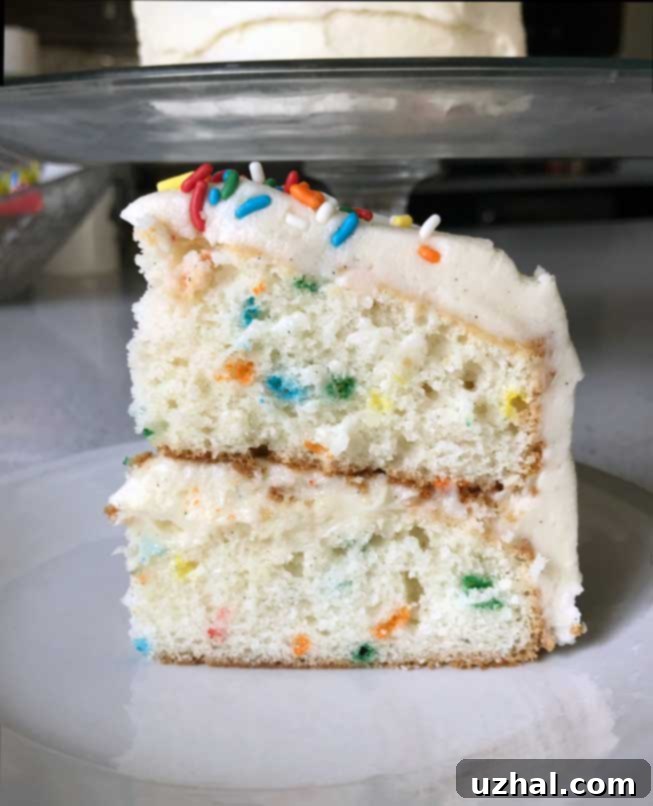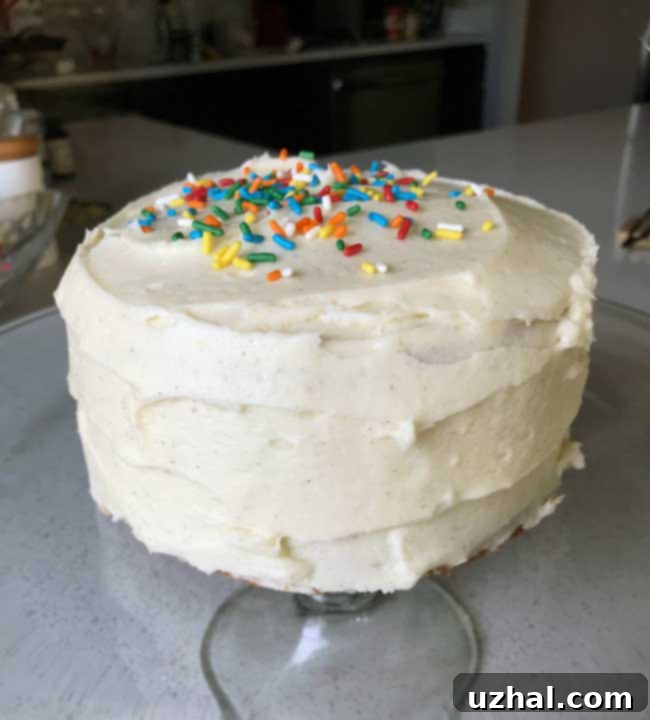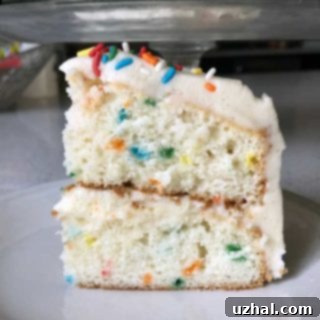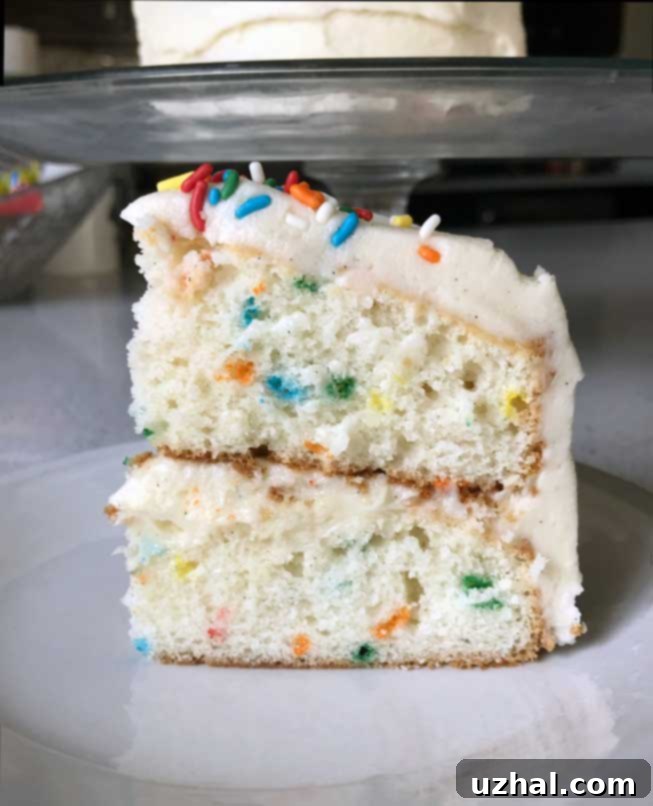The Perfect Six-Inch White Cake: A Delightful Small Batch Celebration Recipe
There’s a special joy in baking, and sometimes, the biggest pleasures come in smaller packages. For those of us who appreciate a freshly baked cake but don’t always need a grand, multi-tiered creation, the six-inch round cake pan is an absolute game-changer. I’ve been thoroughly enjoying scaling down my favorite larger recipes to fit these charming smaller pans, and the results have been consistently delightful. We simply haven’t had many occasions lately that call for an enormous cake, but my love for baking them remains strong. This desire for delicious, manageable portions led to the creation of this exquisite Six-Inch White Cake recipe – a perfect treat for smaller gatherings, intimate celebrations, or simply to satisfy a craving for something sweet and homemade without the excess.

This recipe focuses on crafting a moist, tender crumb with a classic white cake flavor that truly shines. It’s incredibly versatile, making it ideal for any occasion – from a casual weeknight dessert to a charming birthday celebration. The smaller size means less effort, quicker baking times, and easier cleanup, all without compromising on flavor or texture. Get ready to fall in love with the convenience and charm of baking small!

Why a Six-Inch Cake is Your New Best Friend for Baking
In a culinary landscape where elaborate desserts often seem intimidating, the six-inch cake offers a refreshing and practical alternative. Its compact size makes it incredibly versatile and perfect for a variety of situations. Firstly, it’s ideal for smaller households or intimate gatherings where a standard 8 or 9-inch cake would result in excessive leftovers. Nobody wants delicious cake to go to waste, and a six-inch cake ensures every slice is savored, creating just enough for a few servings without overwhelming your refrigerator or your guests.
Beyond practicality, mini cakes are also less intimidating to bake and decorate. With fewer layers and a smaller surface area, even novice bakers can achieve stunning, professional-looking results. This means you can experiment more confidently with different frosting techniques, intricate sprinkle designs, or simple fresh fruit garnishes without feeling overwhelmed by a large canvas. The baking time is also significantly reduced, allowing you to whip up a beautiful dessert even on a busy schedule. Plus, there’s an undeniable charm to a perfectly portioned, personal-sized cake. It feels more special, more curated, and often more delightful to present and enjoy, making it an excellent choice for any occasion that calls for a touch of homemade sweetness.
Understanding the Key Ingredients for a Superior White Cake Texture
Achieving the perfect texture and flavor for this light and airy Six-Inch White Cake relies on a few critical ingredients. Let’s break down why each plays an essential role in contributing to the cake’s delightful characteristics:
- Cake Flour: This is non-negotiable for a truly delicate and tender white cake. Cake flour has a lower protein content (around 7-9%) compared to all-purpose flour (10-12%), which results in less gluten development when mixed. Less gluten means a softer, finer crumb that melts in your mouth, which is the hallmark of a classic white cake. Do not substitute with all-purpose flour if you can help it, as it will yield a denser, tougher texture.
- Buttermilk: Using room temperature buttermilk is key for both flavor and texture. Its natural acidity reacts with the baking powder, helping the cake rise beautifully and contributing to a light, airy crumb. It also adds a subtle tang that wonderfully balances the sweetness of the cake. Ensuring it’s at room temperature allows it to emulsify properly with the other ingredients, leading to a smoother, more uniform batter. If you don’t have buttermilk, you can make a substitute by adding a tablespoon of lemon juice or white vinegar to regular milk and letting it sit for 5-10 minutes.
- Egg Whites: A pure white cake gets its characteristic bright color (or lack thereof) from using only egg whites, deliberately omitting the yolks. Whipping the egg whites separately until stiff peaks form and then carefully folding them into the batter incorporates a significant amount of air, which is crucial for the cake’s incredibly light and fluffy structure. The note in the recipe about discarding a portion of whipped egg whites is to ensure the correct volumetric amount, crucial for the delicate balance and rise of this specific cake size.
- Unsalted Butter: Using softened unsalted butter allows you to control the salt content of your cake precisely. More importantly, softened butter creams beautifully with sugar, creating a light and airy base for the batter. This creaming process traps tiny air pockets, which expand during baking and contribute significantly to the cake’s lift and tender, open crumb.
- Vanilla/Almond Extract: While pure vanilla extract is a beloved staple for its warm, sweet notes, adding a touch of almond extract can truly elevate the flavor profile of a white cake. It imparts a subtle, slightly nutty complexity, often lending that unmistakable “bakery” taste that many adore. It complements the vanilla wonderfully without overpowering it, adding an extra layer of gourmet flavor.
Frosting for Six Inch White Cake: The Perfect Companion
A beautifully baked cake deserves an equally delicious and complementary frosting. For this delightful Six-Inch White Cake, I initially considered a rich, elaborate buttercream, perhaps one with a custardy base. However, at the last minute, I opted for Stella Parks’ celebrated recipe for Classic American Buttercream. This choice proved to be excellent, providing a wonderfully creamy, sweet, and stable frosting that perfectly complements the light texture of the cake. American buttercream, often made with butter, confectioners’ sugar, milk or cream, and flavorings, is known for its simplicity, ease of preparation, and vibrant flavor, making it a favorite for many home bakers. It holds its shape exceptionally well for piping intricate designs and provides a smooth, elegant finish for a professional-looking cake, especially when you’re aiming for that classic birthday cake aesthetic with sprinkles.
While American buttercream is fantastic and a go-to for its straightforward appeal, the world of frostings is vast and exciting, offering endless possibilities for customization. Perhaps next time, I’ll venture into a Swiss Meringue Buttercream or explore one of the many other delightful options from Stella Parks’ comprehensive buttercream recipe collection on Serious Eats. Swiss Meringue Buttercream is renowned for its incredibly silky texture, stability, and significantly less sweet profile compared to its American counterpart, which can be a welcome change for some palates. Italian Meringue Buttercream offers similar qualities with a slightly different preparation method involving a hot sugar syrup. There are also tangy cream cheese frostings that provide a delightful contrast, or even a rich chocolate ganache for a more decadent finish. I’ll be sure to update this post if I experiment with any of these other fantastic frostings, sharing my results and recommendations for pairing them with this versatile white cake, ensuring you have the perfect topping for any mood or occasion.
Essential Baking Tips for a Flawless Small Cake
Baking a perfect cake, regardless of size, involves paying attention to a few key techniques. To ensure your Six-Inch White Cake turns out beautifully moist, tender, and evenly baked every time, keep these tips in mind:
- Accurate Measurements are Crucial: Baking is often referred to as a science, and for good reason. While cup measurements are provided, weighing your ingredients (especially flour, sugar, and butter) with a digital kitchen scale is the most accurate way to ensure consistent results. Volume measurements can vary greatly depending on how ingredients are scooped and leveled.
- Room Temperature Ingredients: This tip cannot be stressed enough. Ensure your butter, buttermilk, and egg whites are all at true room temperature. This allows them to emulsify properly, creating a smooth, homogenous batter that traps air efficiently and bakes evenly. Cold ingredients can lead to a lumpy batter and a denser, less tender cake.
- Do Not Overmix: After adding the flour mixture, mix only until just combined and no streaks of dry flour remain. Overmixing develops gluten, which can lead to a tough, chewy, and dry cake, compromising the delicate texture we’re aiming for in a white cake.
- Even Batter Distribution: Divide your batter as evenly as possible between the two prepared pans. This ensures both cake layers bake uniformly and are of similar height, making assembly much easier and resulting in a professional-looking finished cake. Using a kitchen scale to measure the batter in each pan is a fantastic trick for precision.
- Resist the Urge to Peek: Opening the oven door frequently, especially in the first two-thirds of the baking time, can cause the oven temperature to drop and the cake to collapse. Trust your oven and the suggested baking time.
- Test for Doneness Correctly: To check if your cake is done, insert a wooden skewer or toothpick into the center of the cake. It should come out clean or with a few moist crumbs attached, but not with wet batter. If it comes out wet, bake for a few more minutes and re-test.
- Proper Cooling is Essential: Allow the cakes to cool in their pans on a wire rack for the recommended 10 minutes. This allows the cake to firm up slightly, making it easier to handle without breaking. Then, carefully invert them onto the wire rack and let them cool completely before frosting. Frosting a warm cake is a recipe for disaster, leading to melted frosting and a messy result.
Serving Suggestions and Storage for Your Six-Inch White Cake
Once your Six-Inch White Cake is baked, cooled, and beautifully frosted, the fun truly begins! This classic white cake is a versatile blank canvas for creative decoration. Beyond the colorful sprinkles suggested in the recipe for a fun “birthday cake” vibe, consider embellishing it with fresh seasonal berries, delicate edible flowers, a simple elegant drizzle of fruit compote, or even a light dusting of cocoa powder for a sophisticated touch. Pair a slice with a refreshing cup of coffee or hot tea for a cozy afternoon treat, or serve it as the grand finale to a special, intimate meal. Its moderate size makes it ideal for offering individual slices without overwhelming guests.
For storage, an unfrosted cake can be wrapped tightly in several layers of plastic wrap and kept at room temperature for up to 2 days, or frozen for up to 2 months. When freezing, wrap tightly in plastic wrap, then a layer of aluminum foil for extra protection against freezer burn. Thaw in the refrigerator overnight before frosting. Once frosted, the cake should be covered with a cake dome or stored in an airtight container at room temperature for 1-2 days to maintain its freshness and prevent drying out. If your frosting contains fresh cream cheese or other highly perishable ingredients (though this American buttercream is quite stable), refrigeration might be necessary. Always allow a refrigerated cake to come to room temperature for at least 30 minutes before serving for the best texture and flavor, as cold cake can taste dense and less flavorful.
- Birthday Cake Sugar Cookie Bars
- No Egg Chocolate Buttercream Frosting
- Six Inch White Chocolate Cake
- German Buttercream Cream Cheese Icing
- Quick Chocolate Cupcakes with Flour Based Frosting
Recipe

Six Inch White Cake aka Birthday Cake
Anna
Pin Recipe
Ingredients
- 1 ⅓ cups cake flour (not all purpose!) (150 grams)
- 1 ½ teaspoons baking powder
- ⅜ teaspoon salt
- ½ cup buttermilk room temperature (120 grams)
- 1 teaspoon vanilla extract or a combo of vanilla and almond extract
- 1 stick unsalted butter, softened (114 grams)
- ¾ cup plus 2 tablespoons sugar (175 grams)
- 2 ½ large egg whites (see note) (82 grams)
- 1 tablespoon heaping colored sprinkles
American Style Buttercream
- 1 ½ sticks unsalted butter softened (168 grams)
- 2 ¼ cups confectioners’ sugar 270 grams
- 3 tablespoons heavy cream plus more cream (or milk) as needed
- 1 teaspoon vanilla or vanilla bean paste
Instructions
-
Preheat oven to 350 degrees F. Grease and flour two 6-inch round cake pans.
-
First, weigh your flour then sift it with the baking powder. Stir in the salt (it tends to get clogged in the sifter, so it’s best to just stir it in after. Set aside.
-
With an electric mixer, beat the butter and sugar until light and fluffy, scraping sides of bowl often. Beat in the vanilla and almond extract.
-
Using a rubber scraper to stir, add the milk and flour mixture to the batter in thirds, alternating (milk, flour, milk, flour, milk, flour) and stirring until blended. It will be very thick at this point. I
-
With the electric mixer, beat on medium high speed for 20 seconds or until batter is free of lumps and all flour is incorporated.
-
In a clean bowl using clean beaters, beat the egg whites until stiff peaks start to form. Discard ⅓ cup (17 grams) of the beaten egg white and fold the remainder (about 82 grams) into the batter.
-
Stir sprinkles into the cake batter (if using), then divide between the two pans. You should get somewhere around 10 oz/280 grams per pan.
-
Bake at 350 for 28 to 30 minutes. Let cool on a baking rack for 10 minutes, then carefully turn from pans. Let cool completely.
-
To make the frosting, beat the butter with an electric mixer until fluffy, then gradually beat in the confectioners’ sugar. Beat in the cream and vanilla, using more cream (or adding a little milk) to thin if needed.
Notes
